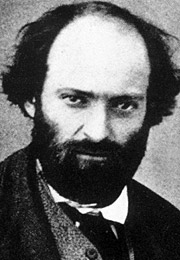


Watercolor and graphite on buff wove paper
22.9 x 31 cm. (9 x 12 3/16 in.)
L.1988.62.36
Artist’s son, Paul Cézanne (1872–1947), Paris; [sold to Bernheim-Jeune, Paris, 11 Mar. 1907]. [Paul Cassirer (1871–1926), Berlin]. Georg T. Reinhart (1877–1955), Winterthur, Switzerland, by 1922; by descent to estate of Georg T. Reinhart. [Peter and Fritz Nathan, Zurich]; Henry Pearlman, by Mar. 1956; Henry and Rose Pearlman Foundation, 1982.
This watercolor belongs to a group of late pictures of skulls, a theme that Cézanne had dealt with early in his career, when he was clearly interested in their symbolic value. Here, the skull is treated almost as an academic exercise, with the repeated contour lines demonstrating the artist’s preoccupation with drawing the complex volumes of a cranial sphere.
By reducing everything else to a series of lines and shapes—including the books possibly indicated in the background—Cézanne emphasized the stark reality of the skull.
Some collectors harbor good feelings toward other collectors, and I believe I am one. Not long ago, another collector called me on the telephone, saying that he had just…
Some collectors harbor good feelings toward other collectors, and I believe I am one. Not long ago, another collector called me on the telephone, saying that he had just returned from a Zurich gallery and he had seen a wonderful Cézanne watercolor of a skull. As his wife objected to having a skull in their home, and he wasn’t going to buy it, he told me the price, and the name of the dealer in Zurich. Based on his description I cabled the dealer in Zurich and told him I was buying the skull, and to ship it on to me, which he did. It is a great watercolor, and I enjoy having it in my collection.

Paul Cézanne (1839-1906)
Cézanne is recognized as one of the great innovators of late 19th- and early 20th-century art, whose work has influenced countless modern artists. With an introverted temperament and generally anti-establishment stance, Cézanne forged a new approach to painting that sought not only to reflect nature but also to express his own response to it. Although during his formative years he exhibited with the Impressionists, he ultimately felt at odds with their emphasis on fleeting experience, seeking greater solidity through painterly form and structure.
Born in Aix-en-Provence, Cézanne studied drawing early on, but, fulfilling his father’s wishes, he later enrolled in university to study law. In 1861, however, he left for Paris, where he studied at the Académie Suisse and copied Romantic and Baroque art at the Louvre. Failing to gain entrance to the École des Beaux-Arts, and constantly rejected by the official Salon, Cézanne rebelliously painted in an intense, even violent, manner, with thickly encrusted paint. Finding a mentor in the Impressionist painter Camille Pissarro, in the 1870s Cézanne lightened his palette and started working directly from the landscape. He was influenced by the solidity of Pissarro’s brushwork and compositional structure, yet, like Paul Gauguin, whom he met in 1880, he sought to express his own personal perceptions and sensations through his views of nature.
By the late 1870s, Cézanne’s paintings showed increasing emphasis on mass and structure, and he developed a system of parallel brushstrokes, known as his “constructive stroke,” that conveyed the volume of both form and space. With mind and eye working in concert, Cézanne built up his pictures slowly and deliberately, often while directly confronting his motif, whether a landscape, still-life, or portrait. In Aix, the prominent form of Mont Sainte-Victoire became one of his dominant motifs from the mid-1880s until the end of his life. Attracted to its enduring geometric form and the changing views offered by different light and angles, Cézanne created more than thirty paintings in oil and watercolor that conveyed his intense examination of the subject’s underlying structures as well as the shifting nature of perception.
Cézanne used the medium of watercolor to experiment with form and structure, creating a wide range of effects through transparent planes of color and strokes of pencil. The exceptional luminosity of watercolor allowed him to play with light as a constructive element, while often using blank passages of paper to heighten the sense of space and form. Cézanne’s watercolors thus had a great influence on his oil paintings, seen particularly in his use of exposed areas of blank canvas as a constitutive element and passages that reveal open compositional structures, as exemplified in Route to Le Tholonet. Many successive generations of artists, from the Cubists and Fauvists to Abstract Expressionists, would be influenced by Cézanne’s experimental legacy.